Timothy Riesterer's Blog, page 6
July 2, 2020
The Three Waves of Sales Enablement
The post The Three Waves of Sales Enablement by Tim Riesterer appeared first on Corporate Visions.
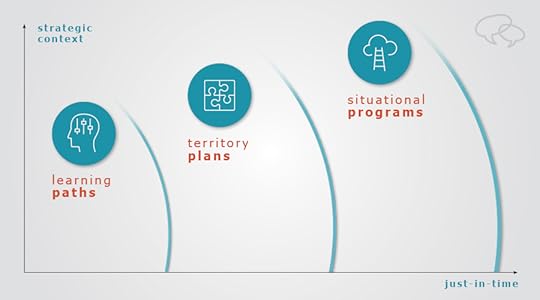
In Alvin Toffler’s book, “The Third Wave,” he talks about society’s transition from the Industrial Age (Second Wave) to the Information Age (Third Wave). Toffler considered the Agricultural Age as the First Wave transition from our hunter-gatherer origins.
You can think of training and enablement programs as similar waves along a continuum.
As you move from left to right across the x-axis, your enablement programs become more flexible and more situational. As you move up the y-axis, those programs gain more executive altitude, becoming more strategic and immediately impactful to the company’s growth agenda.
To move up and to the right in this model, your enablement organization must become faster, more flexible, and more responsive, equipping the field to address more acute, must-win business challenges and market opportunities.
The First Wave: Learning Paths

The first wave in training and enablement is represented by traditional Learning Paths, the original development programs. Like society’s big, first wave—the Agricultural Age—Learning Paths were once a breakthrough.
Programs such as onboarding, competency map-based training, role change, and tenure-based options, as well as the occasional global rollout of a new process or technology, could separate one organization from another.
Learning Paths such as these follow a planned, cataloged, and calendared process, teaching people what they will need to know (at some point) in their daily jobs and careers. These programs could take months or even years to roll out across your entire organization.
Still, for companies that executed Learning Paths better than other companies, it became a differentiator in terms of market performance. And, it made those companies a magnet for top talent.
Over time, Learning Paths have become the standard at most companies. They remain foundational to any good learning and enablement program. But, just as the first wave of agricultural society gave way to the second wave of industrial society, so too Learning Paths transitioned to more situational, Territory Plan-based learning and enablement.
The Second Wave: Territory Plans
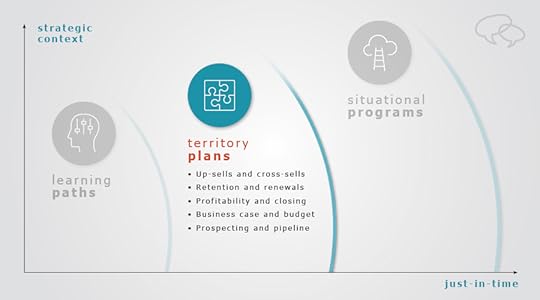
The second wave of sales enablement, moving up and to the right, is what we call the Territory Planning wave. Programs in this wave are based on the sales managers’ decisions about what their teams and territories need to make quota. It also includes an examination of key performance indicators for individual reps to determine training needs, especially now that CRM data is more prevalent.
For example, a manager may look across their team and territory for the upcoming year and see that their revenue number is highly dependent on acquiring new customers. Whereas, another manager may see their territory and quota as relying most heavily on expanding existing customers.
Key performance indicators can also tell you which reps are struggling in critical areas such as:
Prospecting and Pipeline Creation – Identify reps with “starving funnels” who need programs to help them convince prospects to change and choose you.Proposal and Deal Closing – Find the reps with “constipated pipelines.” These reps have lots of proposals, but too many stalled, no-decision deals. And they need support building better executive-level business cases.Negotiations and Discounting – Review deal profitability to find the “unscrupulous discounters.” These reps can close the business but give too much away, and they need help protecting your pricing and margins.Renewals and Price Increases – Determine where your big subscriptions or contracts are coming due helps you find the “business defenders,” whose year depends on avoiding churn and retaining key clients.Upsells and Cross-Sells – Analyze existing customers to identify white space opportunities for upgrades and add-on sales. Then you can identify the “land and expanders” you need to help grow existing accounts.
Once you know what each manager needs for their territory, and you identify the cohorts of sellers who are lagging in each of these areas, you can provide programs more closely aligned to the revenue and growth targets of the company.
Imagine executing a plan for the year that you can show directly addresses the most significant needs of each manager and rep relative to hitting their quota?
Before you assume an approach like this isn’t scalable, look again.
Territory-based plans essentially require you to have a training and enablement curriculum available for the five main KPIs mentioned above. Getting your messaging, content, skills, and coaching synched to each of those five areas gives you the flexibility to assess what individuals need, and then put them in those respective programs. It’s a manageable approach to bespoke training.
The other benefit is that each of these five areas connects to something measurable where most companies already have access to data. You can use the data to determine who needs what and then monitor that same data to see if the programs improved the desired KPI for that specific territory and/or rep.
In this way, your training and enablement programs can be better tied to outcomes and overall company performance. That’s why we refer to it as the Second Wave of training and enablement. You’re moving up and to the right, toward more situational relevance and higher executive altitude.
The Third Wave: Situational Programs

The third wave in society was the move from incredible breakthroughs of the Industrial Age to the mind-blowing possibilities of the Information Age. Similarly, training and sales enablement is now poised for a third wave that we call Situational Programs.
These initiatives are tied to the most urgent and strategic needs of the company. High-stakes situations that show up within a quarter and must be addressed immediately. In these situations, you can’t wait multiple quarters to stand up and roll out a program to respond—by then it will be too late.
Examples of situational needs include:
Price increases vital to growth, but must be handled well to avoid churnProduct launches with short windows of opportunity to leverage a competitive advantageMarket changes where customers are looking for essential insight and adviceBusiness strategy shifts that must be communicated well for maximum positive impactCompetitive moves that require a fast, meaningful response to protect your installed base
As you can see, these events are furthest up and to the right on the chart because they happen fast and have significant consequences. They are often driven from the most senior executive levels of the company, with all eyes watching the response and the outcome.
Sales enablement at this level requires aligning the entire organization on the right story and the right skills to tell that story in weeks, not months. This demands flexible and responsive content, deployment options, and “fit for duty” demonstrations of proficiency.
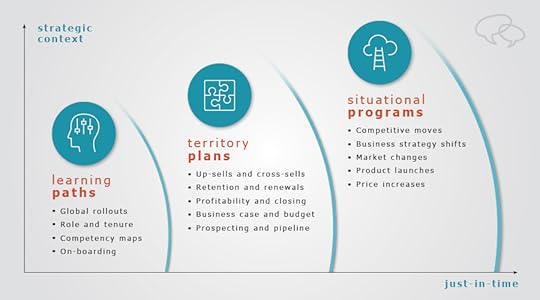
In this blog series, I’m giving you more details on what it looks like to execute Situational Sales Enablement at your company.
Watch our on-demand webinar, The Power of Situational Enablement, to learn more about this new model for training and enabling your team.
Read the other articles in the series:
Winning the Moment with Just-In-Time Situational Sales Enablement
Next up: Examples of Situational Enablement
Thank you for reading this post from Corporate Visions - Differentiate Your Marketing Messages and Sales Conversations.
June 25, 2020
Winning the Moment with Just-In-Time Situational Sales Enablement
The post Winning the Moment with Just-In-Time Situational Sales Enablement by Tim Riesterer appeared first on Corporate Visions.

Too many organizations plan their enablement with a “just-in-case” mindset. They lean on competency maps and learning paths to plot out an annual plan, only to scrap those initiatives and start from scratch when confronted with unexpected events or executive initiatives.
You can’t plan for competitive moves, market changes, or global economic events, but they happen all the time. And when your revenue is on the line, you can’t wait six months or more to train and enable your organization to respond.
These urgent situations call for a faster, more flexible approach to training and enablement—one that doesn’t depend on a long-term, “just-in-case” plan. You need to rally your team with a winning message, skills training, and enablement content to respond quickly and effectively – just in time.
What Does Situational Sales Enablement Look Like?
Imagine if you could stand up the new initiatives you need, exactly when you need them most:
Strategically aligned programs rolled out in days or weeks, not months or years.Tailored, needs-based training based on KPIs versus one-size-fits-all events.Contextual messaging for the moment as opposed to generic value propositions.Demonstrated proficiency (“fit for duty”) instead of spray-and-pray launches.
That’s why you need to think of sales enablement campaigns, not calendars. In this blog series, I’ll give you more details on what it looks like to execute Situational Enablement at your company.
Watch our on-demand webinar, The Power of Situational Enablement, to learn more about this new model for training and enabling your team.
Next up: The Three Waves of Sales Enablement and how they align with the three waves of society’s “ages” (Agricultural, Industrial, and Information).
Thank you for reading this post from Corporate Visions - Differentiate Your Marketing Messages and Sales Conversations.
June 18, 2020
How to Make Virtual Sales Meetings More Engaging and Memorable
The post How to Make Virtual Sales Meetings More Engaging and Memorable by Tim Riesterer appeared first on Corporate Visions.
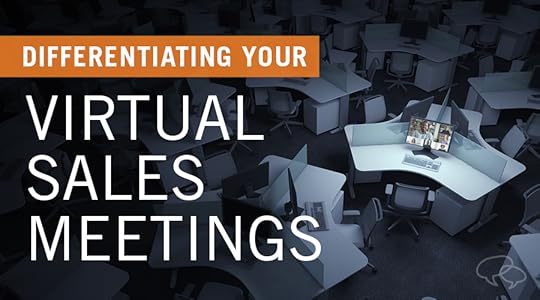
Sales reps who were selling in person just a few months ago are now steeped in a very different (virtual) reality. But how do salespeople feel about virtual sales meetings, versus in-person presentations?
Not good. According to our recent industry survey of over 550 B2B sales reps, nearly 70 percent of salespeople don’t believe that remote selling is as effective as in-person.
One of biggest reasons, according to respondents, is that participants tend to multi-task. In fact, 88 percent of salespeople believe their prospects and customers are likely to multi-task during virtual sales calls. And 83 percent admitted to checking their own email (among other things) during other people’s meetings.
The tendency to multi-task leads to other challenges as well. Sales reps told us that there’s very little interaction during online sales meetings. And it’s harder to build relationships when you’re not meeting face-to-face.
You don’t have the luxury of looking your audience in the eye and pulling them back in when you sense their attention is starting to wander. When selling online, you need to use different tactics to get your buyers’ attention, keep them focused on your presentation, and make sure they remember your message after the call.
6 Ways to Make Your Virtual Sales Meetings Engaging and Memorable
Use these six research-backed techniques for more engaging, memorable, and effective virtual sales meetings.
1. Control Your Message
Our research shows that people will naturally forget up to 90 percent of what you communicate after 48 hours. But that’s not the worst of it. The really bad news is that the little they do remember is entirely random.
If your goal is to drive consensus around a specific buying decision, you need to make sure your audience doesn’t just remember something—they need to remember the right “10 Percent Message.”
Your 10 Percent Message is the single, core message that you want your buyers to remember and act on after the call. To be effective, your 10 Percent Message must be:
FocusedRewardingRepeatableActionable
Keep your 10 Percent Message simple and clear. If you ask your audience to remember too much, they may get the gist of what you’re talking about, but the memory won’t be precise enough to recall your message later on.
2. Focus Their Attention
There’s a popular myth that people have a shorter attention span than 25 years ago. But when you consider the number of people who binge-watch television shows, you know that’s not true. People have a great capacity for prolonged attention. But today, they have a higher threshold for stimulation.
In a remote selling situation, your audience has all the enticing distractions of home and the internet right at their fingertips. To effectively plant your 10 Percent Message among all of those distractions, you need to overcome your buyers’ stimulation threshold with visuals and interactive elements—including color, size, and animation—to draw their attention to the most important information in your slides.
3. Prime Their Brain
If you want to keep your buyers engaged throughout your entire presentation, you need to prime their brains to pay attention when it matters most. That means identifying the key moments where you want to attract more attention and, right before those moments, intensify the stimulus with a powerful “priming” slide.
Research shows that using intense visual stimulus in this way spikes peoples’ attention and engagement in those moments. Not only that—they stay engaged for the next 30 to 60 seconds. So right before you share important information, use a priming slide to re-capture your buyers’ focus and prime their brains to pay attention to what comes next.
4. Create Compelling Dialogue
To keep their attention and focus when presenting your insights remotely, you need to move away from a one-way monologue and skillfully create a two-way dialogue.
But there’s a precise choreography to follow, based on research, for provoking this kind of dialogue. It’s called DIQ, or “Data, Insight, Question.”
Start your dialogue with a piece of data that’s related to an external factor that’s important to your buyer’s business. Turn that data into an insight by placing that information in the context of your buyer’s current business and their situation. Then, and only then, do you ask a question that will provoke a dialogue.
DIQ transfers ownership of the insight and initiates the process of self-persuasion, which ultimately makes your message more persuasive and memorable.
5. Build Dynamic Interaction
There are several different ways to build more dynamic interactions during virtual sales meetings.
Turning on your camera, for example, is one easy way to create more interaction. Most sales reps believe that people multi-task less when their cameras are on. Yet, 82 percent don’t ask their audience to turn on their camera, and 65 percent choose to keep their own camera off.
Live whiteboarding in another way to make your presentation more dynamic. And it differentiates you from nearly every other presentation people will see. Shutting down your slides briefly and drawing your story as you tell it is also a useful way to spike people’s attention.
Finally, using chats and polls can facilitate interaction with everyone on the call, help you discover audience sentiments, and uncover key issues and opportunities. Armed with this insight, you can begin to drive, facilitate, or guide consensus-building during the call.
6. Engage for Impact
The last thing most salespeople want in their presentations is unnecessary friction. But adding friction can actually be a good thing.
A research study conducted by Corporate Visions found that asking your buyer to draw a simple visual story and write down specific notes during your presentation can improve engagement, differentiation, and recall. Plus, it can make your story more convincing.
Using interactive visuals in this way improves how quickly people process the information you share and it helps embed it into your audience’s mind. They become more personally invested in the story. And, they will be able to pass that story along to others in their organization long after your presentation.
More Effective Virtual Sales Meetings
Your sales presentation needs to engage your buyers, hold their attention, and deliver a clear message that motivates them to take action. And this becomes an even greater challenge online.
Using the above virtual sales tips, you can develop and deliver highly compelling sales presentations that drive action—even when you’re not there in person.
To learn more, check out our Remote Selling Survival Kit. In this kit, you’ll get four science-backed resources to help you master remote sales conversations.
Thank you for reading this post from Corporate Visions - Differentiate Your Marketing Messages and Sales Conversations.
June 4, 2020
The Good Room or the Bad Room?
The post The Good Room or the Bad Room? by Tim Riesterer appeared first on Corporate Visions.

Turns out, training effectiveness scores are impacted by “room quality,” even in a virtual environment.
“Training leaders were refusing to teach in the basement classrooms because their scores were lower versus when they would teach in the top floor classrooms with a view of the city and windows all around. Same content, same instructor, consistently different scores between the two venues.”
This is what we heard from a training leader at a Fortune 100 software company a couple of years back. The environment of the classroom accounted for a measurable swing in perceived class quality.
When the world turned upside down this spring, we (Corporate Visions) went from delivering 120 live, in-person classroom training events to 160 virtual classroom training events every month. And that number keeps climbing as companies continue to pivot and discover the value of scaling training, quickly and efficiently, in a virtual environment.
Not Every Virtual Classroom is the Same
Interestingly, we’ve discovered the same “good room, bad room” impact on training experience scores between different web platforms as the company above noted when they compared physical classroom space.
I’m not going to name names here, but it is interesting to see the discrepancy.
Corporate Visions is actively delivering training on 6-10 different virtual meeting platforms. And over the last three months, we’ve measured class scores across these various web conferencing tools.
One of the key performance indicators is how the participants rate the instructor and the event on a scale of 1-5, where four means “better than most” and five equals “best ever.”
When we look at instructor scores across the various platforms, they remain consistent, around 4.9, regardless of what web conference platform was used. But when we compare overall class ratings, there’s a significant difference.
One web conference tool is driving 99 percent fours and fives, while the others average around 90 percent. Same courses. Same instructors. And a 10 percent drop in ratings. The only difference is the platform.
Does this mean that instructors will soon be saying they don’t want to work on certain virtual platforms because their course scores will go down? It’s worth thinking about.
By the way, the top-performing online platform has consistently driven higher course scores than we measured with traditional, live in-person classrooms (99 to 94). Just one more indicator that virtual training can be better than live.
Thank you for reading this post from Corporate Visions - Differentiate Your Marketing Messages and Sales Conversations.
May 6, 2020
Four Must-Win Conversations to Keep and Grow Your Customers
The post Four Must-Win Conversations to Keep and Grow Your Customers by Tim Riesterer appeared first on Corporate Visions.
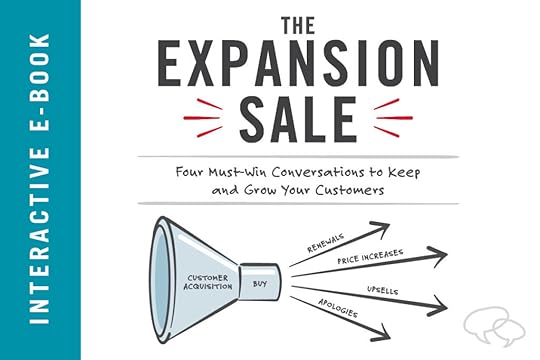
The Expansion Sale e-book will give you research-backed messaging strategies for customer retention and expansion.
As a native Midwesterner, I grew up with an unhealthy phobia of tornadoes. Thankfully, my hometown had the foresight to install a siren warning system that would alert the populace—all 600 souls—to a looming threat should the occasion arise.
The town tested the siren every day at noon, sounding a minute-long ear-shattering blast, rain or shine. Yet somehow the townspeople managed to ignore the piercing wail and go about their business, a few fondly referring to it as the “noon whistle.”
Then one memorable day, the skies darkened. The clouds began to rumble. And the siren went off at 3 p.m.
Thankfully, no tornado touched down in that little town that afternoon, and none have officially touched down in its entire 200-year history. But in that frantic moment, a lesson in marketing, sales, and customer service was born.
Turns out, it wasn’t about the siren at all. It was about the context of the situation the siren was in.
No one cared about the screeching siren when it was doing its thing at noon every day. But when the situation changed to threatening, everyone cared. And they responded accordingly.
It was the different environment that made the siren irrelevant one minute and invaluable the next. It had nothing to do with the tensile strength of the horn or the decibel levels it put out.
It’s a phenomenon called the Context Effect.
The Context Effect in Marketing, Sales, and Customer Success
The Context Effect is defined as the influence of environmental factors on the perception of a stimulus.
The Context Effect is essential to marketing, selling, and customer success as well. It’s not your products or services that get people to respond. It’s their environmental factors, their current situation, that determine their perception of your solution.
Chief among these environmental factors is whether they are a prospect doing something else with someone else (or perhaps doing nothing at all with anyone) or whether they are your existing customer doing that thing with you.
The Context Effect calls for you to develop and deliver a message differently to prospects versus existing customers.
After all, their environment is very different when it comes to responding to your products and services.
But wait! You say you don’t message differently or you’re unsure of the distinction? Then our new book, The Expansion Sale, is for you. And it will completely change your perspective on—and approach to—marketing, sales, and customer success.
The Expansion Sale collects years of exclusive research on the difference between customer acquisition and customer expansion messaging. While there’s been plenty written about how to get new customers, this book will show you how to keep and grow the customers you already have.
After all, according to many analysts your existing customers represent 70–80 percent of your revenue and growth opportunities. Yet most companies take the same one-size-fits-all approach to marketing, sales, and customer success when renewing and upselling existing customers as they did to acquire them in the first place.
Recent research proves this will backfire—badly. In fact, the psychology of the existing customer is 180 degrees different from the psychology of a prospect. That means the stories and skills you use to communicate with them need to be 180 degrees different as well.
Four Must-Win Commercial Moments
There are several things you must do after winning a new customer that are vital to the customer’s experience and satisfaction, including onboarding, change management, adoption, and utilization, not to mention ensuring your customer achieves the results you promised.
These are all important, but the Expansion Sale doesn’t focus on these day-to-day customer success activities.
Instead, it focuses entirely on the four must-win commercial moments in every customer relationship:
RenewalsPrice increasesUpsellsApologies
These are the acute scenarios in which you rally your organization’s marketing, sales, and customer success resources to keep and grow your customers. They’re also the tense situations that register highest on the revenue “Richter Scale,” where much of your (and your company’s) success hangs in the balance.
It’s in these moments you need tested, proven customer conversation message frameworks and skills, rooted in decision-making science and the invisible forces that shape how people frame value and make choices.
The Expansion Sale E-book
If you’re interested in The Expansion Sale but haven’t yet bought your copy of the book, check out our newly released interactive e-book.
Think of this e-book as the Cliffs Notes version of the book. You’ll get specific, practical, and actionable approaches to create and deliver your message for maximum impact in your customer conversations. And after you read the e-book, pick up The Expansion Sale for even more research and insights.
Get The Expansion Sale interactive e-book.
Thank you for reading this post from Corporate Visions - Differentiate Your Marketing Messages and Sales Conversations.
In Case You Missed It: April Showers, When It Rains It Pours!
The post In Case You Missed It: April Showers, When It Rains It Pours! by Rick Weber appeared first on Corporate Visions.

In this monthly “In Case You Missed It” digest, you’ll get caught up with all the Corporate Visions news and updates you might have missed last month.
From a brand-new product launch, to podcast interviews, and a shoutout in Forbes, here’s what the Corporate Visions team was doing in the month of April.
New Product Launch: Mastering Remote Selling Training Program
Remote selling is now required if you hope to hit your quota. But many sales reps have realized that selling on-screen brings some unexpected challenges:
Your presence is reduced to a tiny image in the corner of a web conference.You’re competing for attention with a highly distracting screen environment.Your sales deck becomes the focus—it’s no longer the backdrop for an in-person conversation.Best case, research shows that your audience will only remember 10% of what you show them after 48 hours.
How can you overcome these challenges and deliver a sales presentation that engages your audience, helps them remember your message, and persuades them to buy?
With Corporate Visions’ Mastering Remote Selling training program, you’ll learn to use science-backed techniques to grab and hold your buyers’ attention, make sure they remember your most important message, and persuade them to take decisive action after the call.
For more information about “Mastering Remote Selling” and the science behind this new course, visit: https://cvi.to/master-remote-selling
Also, check out the news coverage in MarTech Advisor and Training Industry:
Corporate Visions Launches Mastering Remote Selling for Improved Customer ConversationsCorporate Visions Introduces New Data-Driven “Mastering Remote Selling” Skills Training
Corporate Visions Named a Top Sales Training Company by Training Industry
Training Industry claims to be “the most trusted source of information on the business of learning.” Their Top Sales Training List is based on thorough analysis of the capabilities, experience, and expertise of sales training providers.
Selection of this year’s Top Sales Training Companies List was based on the following criteria:
Thought leadership and influence on the sales training sector.Breadth and quality of sales training topics and competencies.Company size and growth potential.Industry recognition and innovation.Strength of clients and geographic reach.
Read more about the 2020 Top Sales Training Companies list on TrainingIndustry.com
The Surprising Psychology of Customer Expansion
For more than two decades, sales and marketing have relentlessly focused on “acquiring new logos.” But what happens after a prospect becomes a customer? Should teams use the exact same message when renewing or up-selling existing customers?
Chief Strategy Officer Tim Riesterer digs into the psychological difference between prospects and customers in his article for Highspot.
Read Tim’s full article on Highspot’s blog .
Podcast Appearances
Tim Riesterer sat down with Logan Lyles of the B2B Growth podcast to talk about the new book, The Expansion Sale: Four Must-Win Conversations to Keep and Grow Your Customers. The episode will go live on May 15th, so stay tuned.
Tim also joined The Salesman Podcast to share why up-selling your current customers is the best way to hit quota, now more than ever. Listen to the full conversation here.
Chief Science Officer Dr. Carmen Simon was invited to a LinkedIn live discussion with Michael Krigsman of CXOTalk. The conversation went in-depth about cognitive neuroscience and the power of communication. You can catch the recording of their conversation on LinkedIn.
Why Even Small Decisions Are Difficult Right Now
Dr. Carmen Simon was cited in an article from Forbes contributor and business coach Chris Westfall. Decision-making can be challenging, especially as you navigate an uncertain business landscape. But according to Dr. Simon, experience is vital in effective decision-making, because the past helps you predict the future.
Read the full article in Forbes to dive deeper into effective decision-making.
From the Corporate Visions Blog
Looking for more research-backed insights to improve your marketing and sales? Look no further than the Corporate Visions blog.
Here’s what published in April:
Customer Churn is Coming. What Can You Do? Tim Riesterer covers a recent Gainsight report on customer churn and offers to help companies who want some advice.Why Isn’t Everyone Whiteboarding? Our research shows that using a whiteboard in your sales presentations can lead to better results than PowerPoint. But most sales reps still won’t let go of their clickers.Remote Sales 101: Ten Easy Tips to Improve Your Online Meetings. Use these 10 practical remote selling tips and techniques to improve the quality of your online meetings.
That’s a wrap! Another “In Case You Missed It” digest will arrive next month. Until then, stay connected with Corporate Visions on Twitter and LinkedIn to see the latest.
Thank you for reading this post from Corporate Visions - Differentiate Your Marketing Messages and Sales Conversations.
April 30, 2020
Remote Sales 101: Ten Easy Tips to Improve Your Online Meetings
The post Remote Sales 101: Ten Easy Tips to Improve Your Online Meetings by Anton Rius appeared first on Corporate Visions.

Remote sales are the only kind of sales these days. But if you aren’t familiar with the format already, learning how to sell effectively online can feel quite daunting.
In our recent industry survey of over 500 B2B salespeople, 70 percent said they don’t believe remote sales presentations can be as effective as in-person meetings.
Why the lack of confidence? Sales reps told us that remote selling is more challenging than in-person meetings because:
Your audience is multi-tasking. When you’re selling in person, you generally have your buyers’ undivided attention. People aren’t as prone to checking their email, checking their phone, or opening their web browser when you’re talking to them face-to-face.
You can’t read body language. You don’t have the luxury of looking your audience in the eye and pulling them back in when their attention starts to wander.
Your presentation is too passive. Unless you make an effort to interact, your audience can just sit back, check out, and work on other tasks while they listen to your monologue.
What can you do?
Consider this Remote Sales 101. Below, you’ll find 10 practical remote selling tips and techniques that you can use to improve the quality of your online meetings.
10 Remote Sales Tips to Improve the Quality of Your Meetings
1. Dial Down Distractions
You can’t avoid every distraction caused by participants during your call. But you can, at least, control whether or not you add to those distractions. Before every call, silence your phone, close your email and messaging apps, and make sure you won’t be interrupted for the duration of the meeting.
The goal is to make it as easy as possible for your participants to focus on you and your presentation. To that end, consider how your appearance comes across to your meeting attendees, too. Your background, lighting, sound, and video will all impact your buyers’ ability to pay attention and stay engaged.
2. Simplify Your Background
Your background should look clean, professional, and distraction-free. You don’t necessarily need a high-end studio backdrop or a green screen, but you probably don’t want your audience looking at a pile of laundry, a messy room, or pets walking around behind you—you want them focused on you.
You might be tempted to use a virtual background for your online meetings. But if you do, be aware of how your audience perceives it. Virtual backgrounds can often look pixelated and unrealistic, which could become an unnecessary distraction during your presentation.
A simple white backdrop is always a reliable option. Otherwise, choose a tasteful and uncluttered location that doesn’t pull attention away from your presentation.
3. Get Your Lighting Right
If your light source isn’t bright enough, your video might look grainy. And if you don’t position your lighting properly, people won’t be able to see your face while you’re presenting.
Make sure to position your light source in front of you. Bright, natural light from a window is ideal, but if that isn’t possible, use a simple two-point lighting setup. Place one light on either side of your monitor to create even, soft lighting for your video calls.
4. Check Your Sound Quality
Poor sound is another big distraction that gets in the way of your presentation you’re selling remotely. Depending on the device, your default microphone and speakers might make your voice sound garbled, tinny, or far away. Thankfully, sound quality can be greatly improved with a few minor upgrades.
One way to reduce background noise and improve sound quality is by using headphones with a built-in microphone. Headphones also prevent your meeting attendees from hearing your email and Slack notifications (in case you forgot to turn those off).
Alternatively, using a tabletop USB microphone can make your voice sound crystal clear to your audience. You may need to test the settings and positioning of the microphone beforehand. But once you set it up, an external microphone can greatly improve your sound quality on remote sales calls.
5. Test Your Video Quality
Depending on what kind of camera is built into the computer or device you’re using for online meetings, you might consider upgrading to a higher resolution webcam. This isn’t always necessary, but poor quality or low-resolution video can become an unwanted distraction for your audience.
6. Position Your Camera Well
You should be the focal point of your video when you’re on screen. At the same time, you don’t want your webcam pointing straight up your nose. So be mindful of how you position your camera. Ideally, your camera should sit at, or slightly above, eye level.
Think about the space around you, too. You typically want your head and shoulders to be visible onscreen, without leaving too much or too little space above your head. If you sit too far away from your camera, you might be perceived as disengaged from the conversation. But sitting close to the screen could make your viewers feel like you’re too close for comfort.
7. Dress the Part
This might sound obvious, but some sales reps assume that because they’re working from home, they can dress more casually during remote sales calls than they would in-person. That’s not the case.
Dress like you would for an in-person meeting. Your viewers will appreciate your effort to appear professional and well-groomed during your presentation.
8. Set Expectations
You’ve probably had some practice conducting remote meetings by now, but don’t assume that your attendees have that same level of experience.
When you send out your meeting invite, include instructions for how to enter the meeting password, join audio using their computer, or use the dial-in phone number. Briefly review with your participants how they can mute and unmute their microphones, use the chat feature (if you want them to), and other basics that will help them participate in the discussion.
9. Turn on Your Camera
Most salespeople (88 percent) who responded to our industry survey believe their audience is likely to multi-task during online meetings. And while the vast majority (89 percent) think people multi-task less when their cameras are on, 82 percent don’t ask their audience to turn on video. Two-thirds of sellers don’t even turn on their own cameras.
Simply put, if you want to discourage multi-tasking and other distractions from pulling peoples’ attention away from your presentation, turn on your camera. And ask your participants to do the same.
10. Encourage Interaction
Beyond using the chat feature and asking people to turn on their cameras, you can also encourage interaction on remote sales calls by asking questions.
Ask clarifying questions at key moments in your presentation to make sure your audience understands you. And ask reflective questions to give your audience time to pause and think about how their current situation relates to your message. If your meeting software allows, you can also consider using real-time polls.
Annotation is another powerful tool that encourages interaction, but it takes some practice. Using the Pen feature in PowerPoint, you can write down participant feedback in real-time, or highlight important information on your slides.
Go Beyond Remote Selling Best Practices
These 10 remote selling techniques will give you the foundation for great online sales meetings. But if you truly want to stand out from your competition, you need to go beyond these 10 “best practices.”
The way you look and sound to your audience is important. But even with the perfect background, lighting, and technical setup, your sales presentation could still fall flat.
Why? During your presentation, your presence will be shrunk down to a tiny image in the corner of a computer screen. And your sales deck (not you) is the most visible and visual part of your buyers’ experience.
Your slide presentation needs to carry the day—it should engage your audience, hold their attention, and deliver a highly memorable message that inspires action.
To learn more about creating highly captivating remote sales presentations, check out our Remote Selling survival kit. In this kit, you’ll get four science-backed resources to help you master remote sales conversations.
Thank you for reading this post from Corporate Visions - Differentiate Your Marketing Messages and Sales Conversations.
April 23, 2020
Why Isn’t Everyone Whiteboarding?
The post Why Isn’t Everyone Whiteboarding? by Tim Riesterer appeared first on Corporate Visions.

A new survey shows that 77 percent of salespeople rely on PowerPoint for their in-person presentations, while only 6 percent use whiteboarding. The whiteboard vs PowerPoint disparity jumps even higher in remote selling situations, where slides are used more than 83 percent of the time while using a digital whiteboard, or any kind of annotation, drops to below 4 percent.
Five years ago, we did a breakthrough study with Dr. Zakary Tormala of the Stanford Graduate School of Business. The goal of the research was to compare whiteboard-style visuals to the traditional PowerPoint visuals of stock photography and bullet points. We also tested the effectiveness of more Zen-style presentations based on metaphorical imagery and a few words.
In the study, we divided over 700 participants into three groups. Each group was presented with the same story and voiceover, but the visuals used to depict the story changed.
The result? Participants who viewed the story accompanied by whiteboard visuals remembered 14 percent more than those who watched a traditional PowerPoint.
In addition, the whiteboard approach scored, on average, 10 percent higher in terms of perceived uniqueness, interest, credibility, and trustworthiness of the speaker. Remember, it was the same story and voiceover in all three cases.
Most importantly, whiteboard visuals handily defeated both types of slide presentations in actionable areas such as “willingness to share with others” and “intent to change,” based on what they saw and heard.
You’d think such dramatic results in favor of whiteboards would drive sellers to pick up the markers and put down the clickers, right? After all, aren’t sellers always looking for an edge to be different, memorable, and more convincing than their competitors?
Apparently not.
Whiteboard vs PowerPoint? Here’s What Sellers Think
As I mentioned at the beginning, in a recent industry survey conducted by Corporate Visions, only 5.9 percent of companies primarily use whiteboards during their in-person sales presentations. In contrast, 77.2 percent rely on PowerPoint. Even printed literature (8.8 percent) is used more often than whiteboards as a visual presentation aid (we’re talking old-school brochures and flyers).
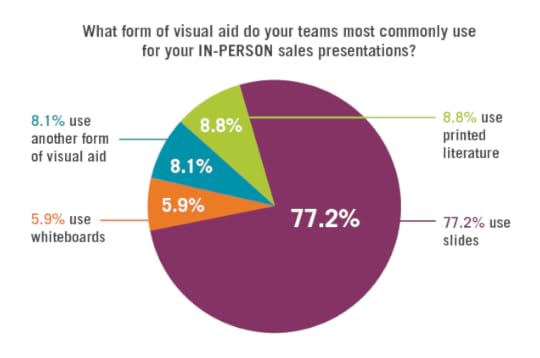
Sellers’ unwavering commitment to using slide presentations becomes even more evident when you look at the web conference-based virtual selling environment we all find ourselves in today.
Despite the popularity of touch screens and annotation tools, 83.1 percent of sellers still use PowerPoint slides on remote sales calls, while whiteboard visuals plummet to less than 4 percent when sellers go online. In fact, presenters are more than twice as likely to use “no visuals” at all rather than draw whiteboard visuals.

Here’s the irony of these results:
The use of whiteboards seems paltry when you consider there is scientific evidence to prove it significantly outperforms traditional slide decks. And it’s even more amazing when these same survey respondents admit they feel that whiteboarding is a better option than PowerPoint.
You read that correctly. When asked, “Which approach do you believe is most effective,” nearly half (43.4 percent) said whiteboards—not PowerPoint.

The Choice is Yours
If you’re a seller, you can draw two conclusions from these survey results:
Set your mind on improving your annotation and whiteboarding skills in the digital environment, and you can differentiate yourself from 96% of the other presenters out there.Or, at least make sure you’re doing something to make your PowerPoint presentations stand out from such a noisy, crowded environment.
Check out our Remote Selling Survival Kit to learn more science-backed techniques for developing better remote sales presentations.
Thank you for reading this post from Corporate Visions - Differentiate Your Marketing Messages and Sales Conversations.
April 16, 2020
Customer Churn is Coming. What Can You Do?
The post Customer Churn is Coming. What Can You Do? by Tim Riesterer appeared first on Corporate Visions.

Recent research from Gainsight, a customer success software company, paints a gloomy picture for technology companies when it comes to customer renewals and upsells.
Of the survey respondents, consisting of top-performing private cloud and SaaS companies:
77.5 percent believe their net retention rate will decrease between 3-20 percent compared to their original business plans.Of those companies, 40 percent believe it will drop by 11 percent or more.
According to Nick Mehta, Gainsight’s CEO, much of the anticipated decrease can be attributed to down-sells, when customers decrease capacity and eliminate forward-looking demand. This is especially true for firms that serve the hardest-hit vertical markets like hospitality and travel. Not surprisingly, most firms expect upsells and cross-sells to decline versus plan as well.
What Can You Do Differently?
When we released our new book, The Expansion Sale, on February 14th, we had no idea how prescient the topic and content would be. Almost in an instant, new business acquisition has slowed to a crawl, and companies are turning nearly all their focus toward keeping and growing their existing customers.
I’ve been having LinkedIn conversations with people who have read our book and are asking for advice on specific situations. They want to know how to best use the frameworks we provide for renewals (Why Stay) and upsells (Why Evolve). They’re testing their messages with me, and I’m humbled to provide them with some tips and feedback.
We’re grateful that these concepts, which seemed important as we researched them, tested them, and wrote about them, have found such instant and practical application.
Need Advice?
Companies are now going all-in with initiatives around retention and revenue protection. If you’ve read our book and have questions (or a little free advice) during these extraordinary times, I encourage you to reach out to me on LinkedIn at https://www.linkedin.com/in/tim-riesterer/.
I will do my best to answer as many of your questions as I can to help you make positive and productive use out of these concepts. And if the response is overwhelming, we’ll put together a webinar on the topic and reach out to all of you who are interested.
If you haven’t already, check out our e-book, Four Must-Win Commercial Moments in Customer Success, to discover research-backed messaging frameworks for winning more revenue from your existing customers.
Thank you for reading this post from Corporate Visions - Differentiate Your Marketing Messages and Sales Conversations.
March 19, 2020
Virtual Selling Just Became Vital to Your Business
The post Virtual Selling Just Became Vital to Your Business by Jim Moliski appeared first on Corporate Visions.
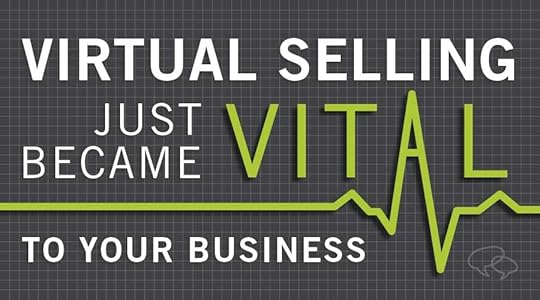
Are your salespeople prepared for the unique challenges of virtual selling?
Before this month, at least 70 percent of sales calls were virtual, according to a study from Inside Sales. With the effects of the current pandemic, that number has skyrocketed.
Great web conferencing platforms are within everyone’s reach,
but don’t make the mistake of thinking that technology is all you need.
Attention and engagement are hard enough to get in a face-to-face meeting. It’s even harder over the web, when you’re a thumbnail image on a conferencing app.
With limited attention, comes less engagement. Closing
complex, high-value deals require you to influence decision-making part of your
buyer’s brain. Getting maximum engagement is a minimum requirement to using
buyer psychology to influence big-ticket deals.
Here are three techniques, backed by science, for driving
attention and engagement during virtual sales calls.
3 Research-Backed Techniques for Virtual Selling
1. Provide Value from the First Minute
It’s never been more important to start a meeting by
delivering value.
If you haven’t already, ditch the “what’s keeping you up at night” questions that are sure to cause eye-rolling, or worse—app switching. Instead, lead with the unique perspective you have from dealing with dozens of companies like the one you’re speaking with. Discovery is important, but only after you’ve established value.
Start the meeting with a fresh idea or unique challenge you’ve
identified though working in your prospect’s industry. Doing so will:
Deliver value from the start so people will see the
benefit of paying attentionFrame the discussion in an area where you offer
unique value Create a safe space for prospects to admit they
have a problem
Learn more about the messaging impact of Unconsidered Needs.
2. Engage Your Audience (Even if it’s Uncomfortable)
With the short supply of attention and engagement, your
sellers are fearful of doing anything that might drive away an interested
buyer.
According to a survey of over 300 B2B salespeople, 42
percent of sellers try to “reduce friction” by keeping the conversation verbal
only. And 46 percent of sellers add only minimal friction, asking
prospects to use a web link to virtually walk through a sales deck. The problem
is, by not asking your audience to do anything, you are making it easier for
them to tune out.
A Corporate Visions study found that adding some friction can often lead to a more productive conversation. Asking a prospect to write down some words or draw a picture increased message effectiveness, seller credibility, and information recall. And, in a live simulation conducted in partnership with a Corporate Visions client, using interactive visuals increased sales by 24 percent month over month and year over year.
3. Lean on Visuals and Make Them Dynamic
The virtual buying experience can be highly distracting. To capture and keep people’s attention, your sales deck needs significantly more animation, movement, and slides to overcome your prospect’s “stimulation threshold.”
In fact, research from Memzy (a Corporate Visions company) shows you need roughly three times the number of slides to communicate the same amount of information in a virtual conversation.
This doesn’t mean you should include three times the
information. Buyers will only remember about 10 percent of what you said 48
hours later. So, it’s more about identifying your most important “10
percent message,” and designing your sales deck so your prospects will stay
engaged and remember your message when it’s time to buy.
Get the proven science behind unforgettable sales presentations in the e-book, Impossible to Ignore.
Make Sure You’re Ready for the Virtual Selling Moment
Virtual selling is now the new norm. If your sales reps aren’t prepared with skills and techniques suited for the virtual sales environment, you risk losing the attention and engagement that’s so critical to winning complex deals.
Using the three techniques above, and the research that
supports them, you can make sure your company is ready to win in the virtual
selling moment.
Thank you for reading this post from Corporate Visions - Differentiate Your Marketing Messages and Sales Conversations.
Timothy Riesterer's Blog
- Timothy Riesterer's profile
- 3 followers



